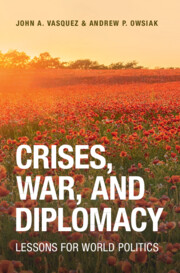Refine search
Actions for selected content:
303 results
14 - The 1971–1973 Cod War
- from Part IV - The Nuclear Era
-
- Book:
- Crises, War, and Diplomacy
- Published online:
- 07 November 2025
- Print publication:
- 20 November 2025, pp 302-335
-
- Chapter
- Export citation
5 - Procedural Grounds of Review
-
- Book:
- The Law and Practice of International Administrative Tribunals
- Published online:
- 27 October 2025
- Print publication:
- 13 November 2025, pp 118-161
-
- Chapter
- Export citation

Crises, War, and Diplomacy
- Lessons for World Politics
-
- Published online:
- 07 November 2025
- Print publication:
- 20 November 2025
Effects of bilingualism on foreign language learning during kindergarten years: investigating underlying mechanisms
-
- Journal:
- Bilingualism: Language and Cognition , First View
- Published online by Cambridge University Press:
- 27 October 2025, pp. 1-17
-
- Article
-
- You have access
- Open access
- HTML
- Export citation

The Mediation System of China from an Interdisciplinary Perspective
-
- Published online:
- 23 October 2025
- Print publication:
- 06 November 2025
Chapter 9 - Mandates and the Termination of Mediation
-
- Book:
- The Peacemaking Mandate
- Published online:
- 12 September 2025
- Print publication:
- 02 October 2025, pp 221-242
-
- Chapter
- Export citation
Chapter 1 - Mandates and Nordic Experiences in International Mediation
-
- Book:
- The Peacemaking Mandate
- Published online:
- 12 September 2025
- Print publication:
- 02 October 2025, pp 1-20
-
- Chapter
- Export citation
Chapter 2 - Conceptualizing Mandates in International Mediation
-
- Book:
- The Peacemaking Mandate
- Published online:
- 12 September 2025
- Print publication:
- 02 October 2025, pp 21-35
-
- Chapter
- Export citation
Chapter 8 - Mandates and the Design of Peace Agreements
-
- Book:
- The Peacemaking Mandate
- Published online:
- 12 September 2025
- Print publication:
- 02 October 2025, pp 183-220
-
- Chapter
- Export citation
Chapter 12 - Mandates
-
- Book:
- The Peacemaking Mandate
- Published online:
- 12 September 2025
- Print publication:
- 02 October 2025, pp 285-306
-
- Chapter
- Export citation
Work passion, work–family conflict, and counterproductive work behaviors
-
- Journal:
- Journal of Management & Organization , First View
- Published online by Cambridge University Press:
- 01 October 2025, pp. 1-13
-
- Article
-
- You have access
- Open access
- HTML
- Export citation
The illusory promise of mediation-based governance
-
- Journal:
- Legal Studies / Volume 45 / Issue 4 / December 2025
- Published online by Cambridge University Press:
- 26 September 2025, pp. 512-536
- Print publication:
- December 2025
-
- Article
-
- You have access
- Open access
- HTML
- Export citation
A relational perspective on callous-unemotional traits in early childhood: Maternal sensitivity and child attachment as developmental antecedents
-
- Journal:
- Development and Psychopathology , First View
- Published online by Cambridge University Press:
- 29 August 2025, pp. 1-13
-
- Article
-
- You have access
- Open access
- HTML
- Export citation
Chapter 5 - The Bookish Sensorium
-
- Book:
- How the World Became a Book in Shakespeare's England
- Published online:
- 09 August 2025
- Print publication:
- 14 August 2025, pp 160-190
-
- Chapter
- Export citation
Chapter 15 - The peaceful settlement of international disputes
-
- Book:
- International Law
- Published online:
- 26 July 2025
- Print publication:
- 31 July 2025, pp 796-857
-
- Chapter
- Export citation
10 - International Intervention, Peacekeeping, and Peacebuilding
-
- Book:
- Civil War and Intrastate Armed Conflict
- Published online:
- 29 May 2025
- Print publication:
- 12 June 2025, pp 319-340
-
- Chapter
- Export citation
How does language distance affect reading fluency and comprehension in English as second language?
-
- Journal:
- Studies in Second Language Acquisition / Volume 47 / Issue 3 / July 2025
- Published online by Cambridge University Press:
- 28 May 2025, pp. 757-773
- Print publication:
- July 2025
-
- Article
-
- You have access
- Open access
- HTML
- Export citation
21 - Dispute Settlement in Old Regime Europe
- from Part II - International Law in Old Regime Europe (1660–1775)
-
-
- Book:
- The Cambridge History of International Law
- Published online:
- 22 April 2025
- Print publication:
- 08 May 2025, pp 682-710
-
- Chapter
- Export citation
10 - Dispute Settlement in Renaissance Europe
- from Part I - International Law in Renaissance Europe (1492–1660)
-
-
- Book:
- The Cambridge History of International Law
- Published online:
- 22 April 2025
- Print publication:
- 08 May 2025, pp 329-356
-
- Chapter
- Export citation
The long reach of puberty: mechanisms underlying sex-dependent links between pubertal timing and adult internalizing symptoms
-
- Journal:
- Psychological Medicine / Volume 55 / 2025
- Published online by Cambridge University Press:
- 14 April 2025, e115
-
- Article
-
- You have access
- Open access
- HTML
- Export citation
